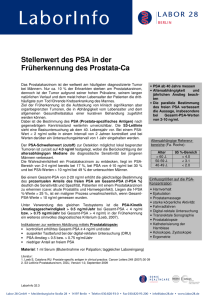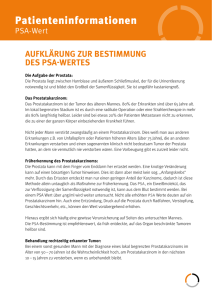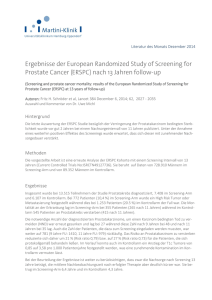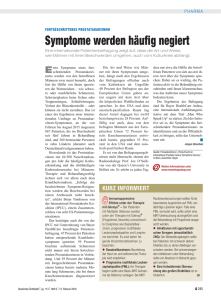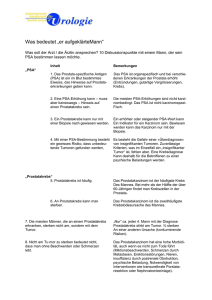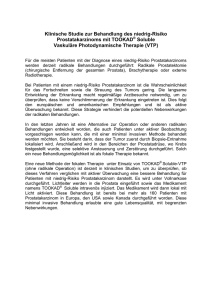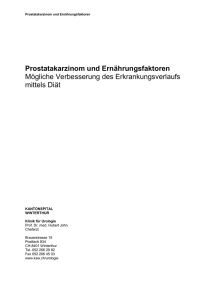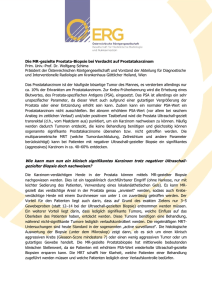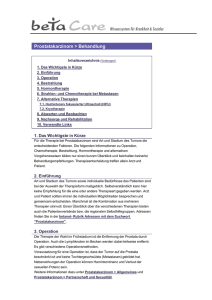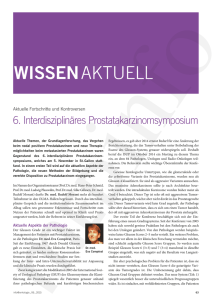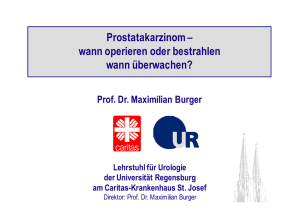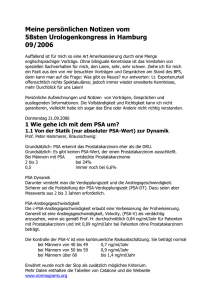UPDATE UROLOGIE
Werbung
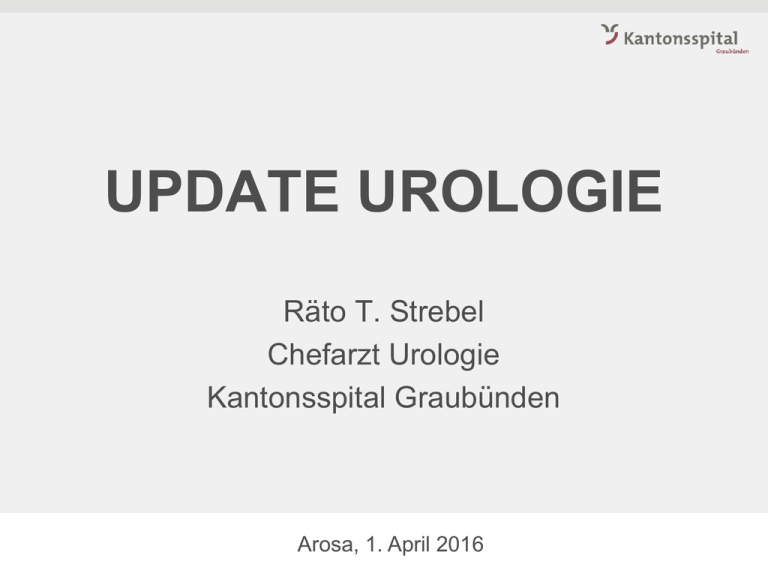
UPDATE UROLOGIE Räto T. Strebel Chefarzt Urologie Kantonsspital Graubünden Arosa, 1. April 2016 News über Nierenstein, Prostatahyperplasie, Prostatakarzinom und Blasenkarzinom. Nierensteine Bildgebung 1895 Conrad Röntgen 1896 John McIntyre: Roentgen rays: Photography of renal calculus. Lancet 1896 1923 Osborne: Roentgenography of the urinary tract during excretion of sodium iodide. JAMA 1923 1995 R Smith: Acute flank pain: comparison of non-contrast CT and IVU. Radiology 1995 Anforderung an Bildgebung • • • • • Lage des Steines? Grösse des Steines? Obstruktion? / Stauung? Morphologie des Hohlsystems? Hohe Sensitivität und Spezifität („Trefferquote“) Steingrösse, -Lage und Abgang • Steinabgangsrate (Lokalisation) – oberes Drittel 12-48% – mittleres Drittel 22-60% – unteres Drittel 45-75% Hubner Eur Urol 1993 • Steinabgangsrate (Grösse) – – – – – 1mm: 2-4mm: 5-7mm: 7-9mm: >9mm: 87% 76% 60% 48% 25% Coll, Varanelli, Smith AJR 2002 Therapie-Möglichkeiten Welche Faktoren beeinflussen die Therapie - Möglichkeiten? Nierenkelch/-becken Klein auflösbar Nein Nein Lokalisation oberer/unterer Harnleiter Grösse Gross Typ / Art nicht auflösbar Infektion Ja Abflussbehinderung Ja Ausstattung, Erfahrung, Patientenwunsch, usw. kein Notfall Passiv Situation Vorgehen Notfall Aktiv ? Notfall - Notfall ! - Infektion? - Einzelniere? - (bilaterale) Stauung? - Therapierefraktäre Schmerzen? Passiv Vorgehen Aktiv Zuwarten Kontrollieren Medikamente Nierensteinzertrümmerung Harnleiterspiegelung Perkutane Nephrolitholaplaxie Laparoskopische Nephro- o. Ureterolithotomie Offene Steinentfernung Nephrektomie Zusatzverfahren: - Laser - Harnleiterschienung - äussere Harnableitung etc, etc,... Operation Eur Urol 2009 MET medical expulsive treatment • Offer α-blockers / LE 1a, GR C • Side effects, off-label, lack of efficacy in recent large multicenter trial 2016 Nierensteinzertrümmerung Extrakorporale Stosswellen-Lithotripsie (ESWL) 1980 Klinik Grosshadern (München) Firma Dornier (Friedrichshafen) HM1 - HM3 „Human Model“ Eingriff Operation AUA 2015 / New Orleans ESWL vs URS Steinbehandlung in Chur Steinbehandlung KSGR 2001-2014 300 250 Anzahl 200 ESWL Pyelolithotomie 150 PNL URS 100 Ureterolithotomie 50 0 2001 2002 2003 2004 2005 2006 2007 2008 Jahr 2009 2010 2011 2012 2013 2014 Steinbehandlung in Chur prozentuale Verteilung Steinbehandlung KSGR 2001-2014 100% 90% 80% 70% ESWL 60% ESWL PNL 50% URS 40% Ureterolithotomie URS 30% Pyelolithotomie 20% 10% 0% 2001 2002 2003 2004 2005 2006 2007 2008 2009 2010 2011 2012 2013 2014 ECIRS Endoscopic Combined IntraRenal surgery ECIRS ECIRS ECIRS • • • • Hosp. 2-3 Tage Sehr hohe Steinfreiheitsrate Technisch anspruchsvoll Tiefe Komplikationsrate Blasenkrebs Blasenkrebs Blasenkrebs Blasenkrebs Prostata Prostatahyperplasie Erstuntersuchung Anamnese Fragebogen (IPSS), RektalPalpation, Urinsediment Optional: Ultraschall, PSA Medikamente • Phytotherapeutika Mässige u.starke Milde Beschwerden Beschwerden RH < 50 ml • Alphablocker RH > 50 ml • 5-Reduktase-Hemmer • Kombination Watchful waiting Medikamente • Tadalafil 5 mg Absolute Op-Indikationen Operation DauerKatheter Prostatahyperplasie Placebo Tadalafil 5 mg Tamsulosin 0,4 mg Oelke et al, Eur Urol 2012 Prostatahyperplasie Prostatahyperplasie Bipolare Technik / in NaCl TURP Müntener, Strebel et al, BJU Int 2006 Prostatakarzinom Screening Prostatakarzinom Screening Hintergrund: PSA Bestimmung ermöglicht Prostatakarzinom-Diagnose deutlich vor klinischen Symptomen Catalona W et al, NEJM 1991 Prostatakarzinom Screening Opportunistisches Screening Screening Spezifisches Screening ≠ Massen Screening Screening Prostatakarzinom Screening Ratio: 1. Prostatakarzinome möglichst in frühem, kurativ therapierbarem Stadium erkennen 2. Senken der karzinomspezifischen Mortalität durch wirksame Therapien Prostatakarzinom Screening Ziele: Karzinome, die nie symptomatisch geworden wären Lokalisierte PCa, die symptomatisch würden Karzinome, die symptomatisch geworden sind Prostatakarzinom Screening Wie? 1. PSA - Bestimmung (Cutoff ? – 4?, 3?, 2.5?) 2. Rektalpalpation 3. Intervall 1-4 Jahre 4. Zwischen 50 (45) – 70 (75?) Jahren 5. Multiparametrisches MRI Prostata Spezifisches Antigen ABER nicht Krebsspezifisch!! PSA > 4 ng/ml PSA < 4 ng/ml Prostatakarzinom Marker Prostatakarzinom Marker Prostatakarzinom Marker PSA Prostatakarzinom Screening Prostatakarzinom Screening Detektionsrate mit mpMRI Gleason score Tumorvolumen (ml) <0.5 0.5-2 >2 GS 6 21-29% 43-54% 67-75% GS 7 63% 82-88% 97% GS > 7 80% 93% 100% Prostatakarzinom Screening Detektionsrate mit mpMRI Gleason score Tumorvolumen (ml) <0.5 0.5-2 >2 GS 6 21-29% 43-54% 67-75% GS 7 63% 82-88% 97% GS > 7 80% 93% 100% Prostatabiopsie • Auffälliger Tastbefund (Rektalpalpation) • PSA > 4.0 ng/ml (> 2.5 ng/ml) • Lebenserwartung (10) 15 Jahre / Guter AZ Prostatabiopsie • Transrektaler Ultraschall / ev. MR-gesteuert • Lokalanästhesie • Antibiotikum -> UROSEPSIS! Prostatabiopsie/MRI Prostatabiopsie Fusion Infektion nach Biopsie • between 2009 and 2013 1924 prostate biopsies were performed in Graubünden • 17 patients diagnosed with prostatitis Average prostatitis incidence: 0.9% p.a. Infektion nach Biopsie • Increase of the Ciprofloxacin resistance rate from 6.8 % to 16.3% • Increase of the Co-Amoxicillin resistance rate from 20.4% to 24.6% Prostatakarzinom Screening Prostate biopsy trends in relation to U.S. Preventative Task Force recommendations against routine PSA-based screening: A time-series analysis Toronto Health Network BioBank database for prostate biopsies Bindi et al, Toronto, PD19-07 AUA 2014 Prostatakarzinom Screening Vor / nach USPTF PSA Screening Empfehlung Vorher Nachher Mediane Anzahl Bx/Monat 66 31 Pat. mit 1. Biopsie (median) 45 24 Low risk PCA (median) 10 5 High risk PCA (median) 17 9 Bindi Bindi et al, Toronto, et al, Toronto, PD19-07 PD19-07 AUA 2014 Prostatakarzinom Screening Vor / nach USPTF PSA Screening Empfehlung Vorher Nachher Diff p-Wert 40 - 49 Jahre 4.2% 4.4% + 4.4% Not sign 50 – 59 Jahre 19.2% 8.5% p< 0.0001 60 – 69 Jahre 19.3% 7.7% - 56% - 60% 70 – 79 Jahre 10.2% 9.3% - 9% Not sign Overall 14.0% 7.0% - 50% p<0.0001 Werntz et al, Portland, PD44-02 p< 0.0001 Prostatakarzinom Patho Gleason score "Aggressivitätsgrad" 2 3 4 5 6 7 8 9 10 Prostatakarzinom Patho Prostatakarzinom Patho Prostatakarzinom Patho Prostatakarzinom Patho Gleason score "Aggressivitätsgrad" 2 3 4 5 6 7 8 9 10 Prostatakarzinom Patho Gleason score "Aggressivitätsgrad" 6 GRADE GROUP 1-5 7 8 9 10 Alter PSA?, Krebstyp? Krankheiten? active surveillance Palliativ Kurative Therapie Fokale Tx? Operation Offen Lap / Da Vinci Roboter Bestrahlung extern Brachy Active Surveillance Hintergrund: Prostatakarzinom-Früherkennung verleitet zu Overtreatment Active Surveillance Tosoian / Carter et al, Baltimore, PD6-04 Active Surveillance • 1298 Patienten mit AS seit 1995 • Medianes f/u 5 Jahre (0,01 – 18 Jahre) • Reclassification: - 5 Jahre 35%, 15 Jahre: 56% - Kurative Therapie n 15 Jahren: 57% • 5 (0,4 %) mit Metastasen oder Tod • Tod durch andere Ursache 24 x höher Tosoian / Carter et al, Baltimore, PD6-04 Active Surveillance Sunnybrook Toronto Johns Hopkins Baltimore Favorable & intermediate risk Favorable risk 993 1298 6.4 (0.2-19.8) 5.0 (0.1-18.0) Freedom from curative Tx at 15 y 55% 43% Proportion PCA death or mets 2.8% 0.4% Entry criteria Number enrolled Median follow-up (years) Tosoian / Carter et al, Baltimore, PD6-04 Active Surveillance Zusammenfassung: • Für selektionierte Patienten • Engmaschiger Follow-up • Overtreatment deutlich reduziert • Hohes karzinomspezifisches Überleben Fokale Therapie Fokale Therapie Fokale Therapie Fokale Therapie Fokale Therapie Fokale Therapie Fokale Therapie Do not offer focal therapy outside clinical trials 2016 Eur Urol 2008 Nach TURP (n = 647) Vor TURP (n = 991) 74% 73% 26% 27% sexuell nicht aktiv sexuell aktiv sexuell nicht aktiv sexuell aktiv ESWL vs URS
